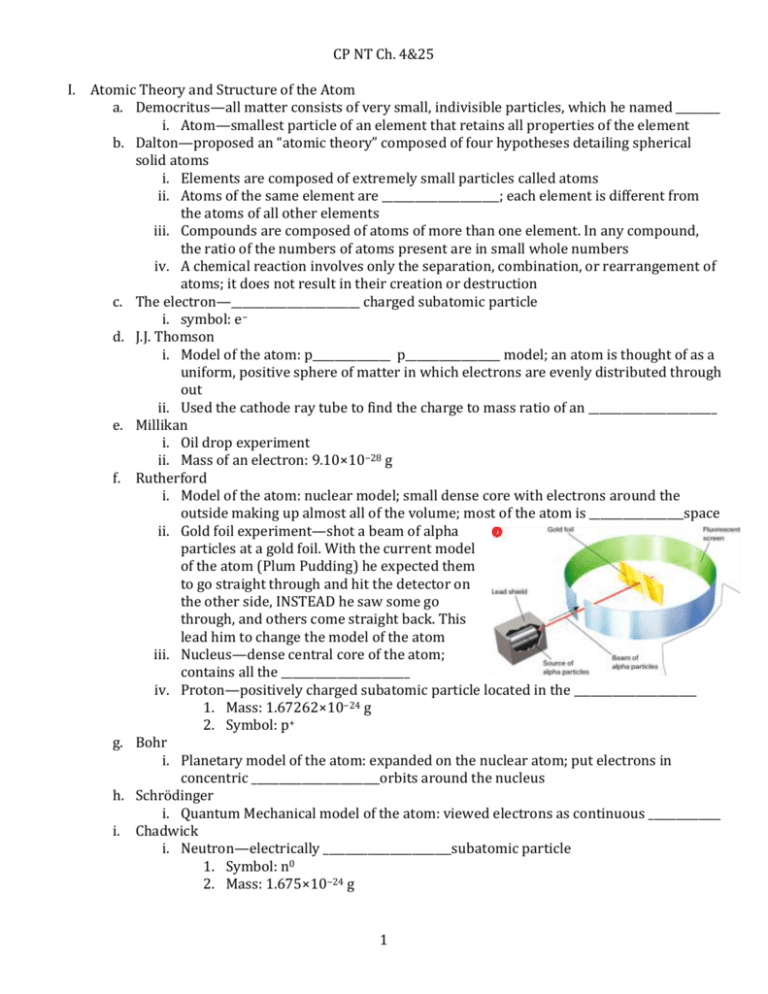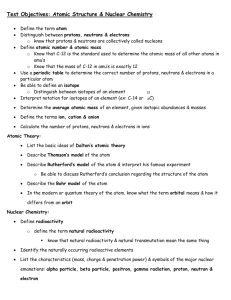NT Ch 4 and 25 word
advertisement

CP NT Ch. 4&25 I. Atomic Theory and Structure of the Atom a. Democritus—all matter consists of very small, indivisible particles, which he named ________ i. Atom—smallest particle of an element that retains all properties of the element b. Dalton—proposed an “atomic theory” composed of four hypotheses detailing spherical solid atoms i. Elements are composed of extremely small particles called atoms ii. Atoms of the same element are _____________________; each element is different from the atoms of all other elements iii. Compounds are composed of atoms of more than one element. In any compound, the ratio of the numbers of atoms present are in small whole numbers iv. A chemical reaction involves only the separation, combination, or rearrangement of atoms; it does not result in their creation or destruction c. The electron—_______________________ charged subatomic particle i. symbol: e− d. J.J. Thomson i. Model of the atom: p______________ p_________________ model; an atom is thought of as a uniform, positive sphere of matter in which electrons are evenly distributed through out ii. Used the cathode ray tube to find the charge to mass ratio of an _______________________ e. Millikan i. Oil drop experiment ii. Mass of an electron: 9.10×10−28 g f. Rutherford i. Model of the atom: nuclear model; small dense core with electrons around the outside making up almost all of the volume; most of the atom is _________________space ii. Gold foil experiment—shot a beam of alpha particles at a gold foil. With the current model of the atom (Plum Pudding) he expected them to go straight through and hit the detector on the other side, INSTEAD he saw some go through, and others come straight back. This lead him to change the model of the atom iii. Nucleus—dense central core of the atom; contains all the _______________________ iv. Proton—positively charged subatomic particle located in the ______________________ 1. Mass: 1.67262×10−24 g 2. Symbol: p+ g. Bohr i. Planetary model of the atom: expanded on the nuclear atom; put electrons in concentric _______________________orbits around the nucleus h. Schrödinger i. Quantum Mechanical model of the atom: viewed electrons as continuous _____________ i. Chadwick i. Neutron—electrically _______________________subatomic particle 1. Symbol: n0 2. Mass: 1.675×10−24 g 1 Particle Symbol Location Relative Charge Relative mass Actual mass (g) -28 Electron 9.11 x 10 Proton 1.673 x 10 Neutron 1.675 x 10 -24 -24 II. How Atoms Differ a. Properties of subatomic particles b. Atomic Number—number of _______________________in the nucleus c. Mass number—__________________number of protons and neutrons in the nucleus of an atom d. Isotopes—atoms that have the same atomic number (# of protons) but different mass Mass number numbers due to different number of neutrons 238 235 𝐴 i. Example 92 U (uranium—235) and 92 U (uranium—238) X 𝑍 atomic number e. Average atomic mass—weighted _______________________of the isotopes of that element i. Formula: % 𝑎𝑏𝑢𝑛𝑑𝑎𝑛𝑐𝑒 𝑜𝑓 𝑚𝑎𝑠𝑠 𝑜𝑓 % 𝑎𝑏𝑢𝑛𝑑𝑎𝑛𝑐𝑒 𝑜𝑓 𝑚𝑎𝑠𝑠 𝑜𝑓 𝑎𝑣𝑒𝑟𝑎𝑔𝑒 𝑎𝑡𝑜𝑚𝑖𝑐 𝑚𝑎𝑠𝑠 = ( × )+ ( × ) 𝑖𝑠𝑜𝑡𝑜𝑝𝑒 1 𝑖𝑠𝑜𝑡𝑜𝑝𝑒 1 𝑖𝑠𝑜𝑡𝑜𝑝𝑒 2 𝑖𝑠𝑜𝑡𝑜𝑝𝑒 2 ii. Example 1: Silver has two naturally occurring isotopes. Ag-107 has an abundance of 51.82% and mass of 106.9 amu. Ag-109 has a relative abundance of 48.18% and a mass of 108.9 amu. Calculate the atomic mass of silver. iii. Rubidium is a soft, silvery-white metal that has two common isotopes, 85 37Rb and 87 85 87 37Rb. If the abundance of Rb is 72.2% and the abundance of Rb is 27.8%, what is the average atomic mass of rubidium? III. Nuclear Chemistry a. Chemical vs. nuclear reactions i. Chemical reactions involve an atom’s _______________________where nuclear reactions involve changing an atoms nucleus ii. Nuclear rxns release about a million times ________________energy than chemical rxns 2 b. Electrostatic force—when like charges repel and opposite charges attract c. Strong Nuclear Force—attractive force that acts between all nuclear particles that are extremely close together; keeps the _______________________together d. Radiation—the emission (and transmission) of energy through space in the form of waves e. Radioactivity—spontaneous emission of particles and/or radiation i. Alpha—particle that contains two protons and two neutrons (He nucleus) 4 4 1. Symbol: 𝐻𝑒 or 𝛼 2 2 2. Charge: +2 3. _______________________penetration form of radiation (blocked by paper) ii. Beta—fast moving electrons 0 0 1. Symbol: 𝑒 or 𝛽 −1 −1 2. Charge: −1 3. medium penetration (blocked by metal foil or wood) iii. Gama—high energy radiation that possesses no mass 0 1. Symbol: 𝛾 0 2. Charge: none 3. _______________________penetrating and damaging type of radiation (not completely blocked by lead or concrete) f. Radioactive—any element that spontaneously emits radiation (shows signs of radioactivity) i. Transmutation—changing of an atom’s nucleus such that a _______ element is formed 1. Alpha and beta radiation are transmutations, while neutron and gamma are not 2. Can be induced (caused) a. Before 1919 the only way to change the nucleus, or cause transmutation, was to wait for _____________________, but in 1919 Rutherford was the first to induce transmutation which proved that nuclear reactions can be produced artificially. b. Can occur by _______________________an atom with alpha particles, protons, or neutrons 3. Transuranium elements—all undergo transmutation and were produced through induced transmutation (elements beyond uranium) ii. Radioactive nuclei are found _______________________the band of stability and undergo decay to gain stability g. Radioactive decay—unstable nuclei losing energy by emitting radiation in a spontaneous process i. Band of stability—stability of the nucleus depends on the neutron to proton _________ h. Radioisotope—isotopes of atoms with unstable nuclei and go through radioactive decay to obtain a more stable nuclei i. Small nuclei—up to 20 protons, usually stable 1. Exception example: Carbon-12 (6 p+ and 8 n0) vs Carbon-14 (6 p+ and 8 n0) ii. Large nuclei—tend to be radioactive, based on ratio of protons to neutrons; ALL nuclei with 83 protons or more are _______________________ i. Electron Capture—occurs when a nucleus of an atoms draws in an electron; also known as beta capture 81 81 0 i. Example: 𝑅𝑏 + 𝑒 → 𝐾𝑟 37 36 −1 3 j. Nuclear Equations i. In a balanced nuclear equation, mass numbers and atomic numbers are ______________ 230 226 4 ii. Example: 𝑇ℎ → 𝑅𝑎 + 𝐻𝑒 90 88 2 iii. Practice 97 0 47 0 1. 𝑍𝑟 → 𝑒+? 4. 𝐶𝑎 → 𝑒+? 40 −1 20 −1 218 4 244 4 2. 𝑃𝑜 → 𝐻𝑒 + ? 5. 𝐶𝑚 → 𝐻𝑒 + ? 84 96 2 2 222 4 3. ? → 𝑅𝑛 + 𝐻𝑒 86 2 k. Half-Life—________ required for one-half of a radioisotope’s nuclei to decay into its products i. After each half-life, half of the existing radioactive atoms have decayed into atoms of a new element 1 total time ii. Equation: 𝑇 = (𝑖𝑛𝑖𝑡𝑖𝑎𝑙 𝑎𝑚𝑜𝑢𝑛𝑡)(2)𝑛 n=number of half-lives; n = time of one half−life iii. Practice 1. Scientists start with 50.0 g sample of a radioisotope. How much is left after four half-lives? 2. Iron-59 is used in medicine to diagnose blood circulation disorders. The halflife of iron 59 is 44.5 days. How much of a 2.000 mg sample will remain after 133.5 days? iv. Carbon-14 dating 1. Process of determining the age of artifacts that were once part of a living organism by measuring the amount of 146𝐶 remaining in that artifact 2. Radioactive and undergoes beta decay 3. Half-life of 5730 years 4. Dates carbon-bearing materials up to 62,000 years Using the graph, about how much strontium-90 remains after 58 years? 4 IV. Nuclear Fission and Fusion a. Fission—the splitting of the nucleus into _________________________ (division) i. Chain reaction—nucleus captures a neutron and splits into fragments and produces three neutrons, then the products start a _____________ reaction (domino effect) 1. Critical mass—the _________________________ mass required to support a selfsustaining chain reaction b. Fusion—_________________________ atomic nuclei to produce a nucleus of greater ________________ i. Releases more energy than fission ii. Example: the sun (all stars) c. Nuclear binding energy—the energy required to break a nucleus into its individual protons and neutrons i. Energy released in a nuclear reaction is much greater than in a chemical reaction d. Mass Defect—when breaking apart a nucleus, there is a change in mass; some of the mass is converted to energy; E=mc2 e. Nuclear Reactors—to keep the chain reaction going without letting it get out of ______________ f. Nuclear Bombs i. Atomic Bomb 1. Uses fission 2. Enriched uranium-235 or plutonium 3. Example: Nagasaki and Hiroshima ii. Hydrogen Bomb 1. Uses fusion 2. 1000 times more powerful 3. uses deuterium and tritium Well-known example of fission: Uranium-235 is struck by a neutron and forms Ba-141, Kr-92, and additional neutrons. 5 A well-known example of fusion: the sun has deuterium and tritium coming together to make a helium atom








